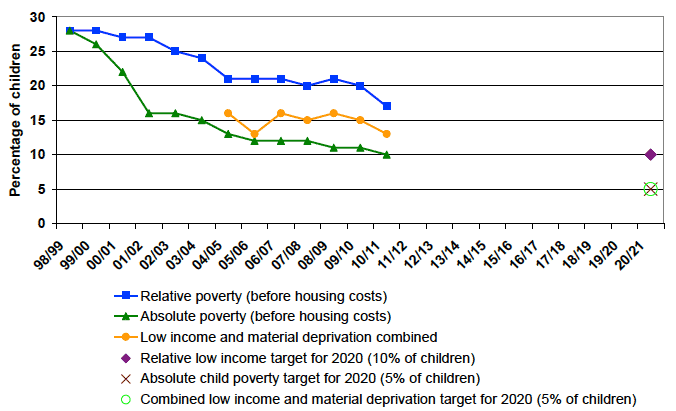Poverty and Income Inequality in Scotland 2010/11
This National Statistics publication presents annual estimates for the proportion and number of children, working age adults and pensioners living in low income households in Scotland. The estimates are used to measure progress towards UK and Scottish Government targets to reduce poverty and income inequality.
This document is part of a collection
Table A9: Economic status of families by equivalised income decile: Scotland 2010/11
Income decile |
One or more self employed |
Single/couple all in full time work |
Couple/one in full time, one part time |
Couple, one full time one not working |
No full time, one or more part time |
Workless, head or spouse aged 60 or over |
Workless head or spouse unemployed |
Workless, other inactive |
||||||||
|---|---|---|---|---|---|---|---|---|---|---|---|---|---|---|---|---|
000s |
% |
000s |
% |
000s |
% |
000s |
% |
000s |
% |
000s |
% |
000s |
% |
000s |
% |
|
1 |
50 |
10 |
30 |
5 |
10 |
1 |
50 |
10 |
60 |
12 |
100 |
21 |
80 |
16 |
130 |
25 |
2 |
40 |
8 |
30 |
7 |
20 |
5 |
70 |
13 |
60 |
12 |
140 |
28 |
30 |
6 |
110 |
22 |
3 |
20 |
4 |
50 |
10 |
80 |
15 |
50 |
11 |
70 |
14 |
130 |
25 |
20 |
4 |
90 |
17 |
4 |
40 |
8 |
80 |
16 |
70 |
14 |
70 |
13 |
70 |
13 |
110 |
22 |
10 |
2 |
50 |
11 |
5 |
30 |
6 |
110 |
22 |
90 |
17 |
60 |
12 |
50 |
11 |
120 |
24 |
10 |
1 |
40 |
8 |
6 |
30 |
5 |
170 |
33 |
110 |
22 |
50 |
9 |
50 |
9 |
90 |
18 |
10 |
1 |
10 |
2 |
7 |
30 |
6 |
190 |
38 |
100 |
19 |
40 |
9 |
30 |
6 |
80 |
16 |
10 |
2 |
30 |
5 |
8 |
30 |
7 |
240 |
48 |
110 |
21 |
30 |
7 |
30 |
6 |
50 |
10 |
0 |
0 |
10 |
2 |
9 |
30 |
6 |
270 |
52 |
110 |
21 |
40 |
7 |
20 |
5 |
30 |
7 |
0 |
1 |
10 |
1 |
10 |
70 |
13 |
260 |
51 |
60 |
11 |
60 |
11 |
20 |
5 |
30 |
6 |
0 |
1 |
10 |
2 |
Total |
370 |
1,440 |
760 |
510 |
470 |
900 |
170 |
490 |
||||||||
Source: HBAI dataset, DWP.
Chart A10: Child Poverty Act Targets:

- Note (1) that the absolute low income target for 2020 is based on children in households whose equivalised income is below 60% of the (inflation adjusted) median income in 2010/11. At present, absolute child poverty is measured by individuals living in households whose equivalised income is below 60% of the (inflation adjusted) median income in 1998/99. The absolute child poverty measure will be rebased to 2010/11 prices from 2011/12 onwards.
- Note (2) that the combined low income and material deprivation poverty indicator is partly based on a suite of questions from the Family Resources Survey about whether people can afford to buy certain items and participate in leisure activities. The goods and services included in the survey are updated periodically and will be updated for next year's publication. This means that the target for 2020 will be based on a different set of goods and services from what is used in these calculations.
Contact
Email: Anne MacDonald
There is a problem
Thanks for your feedback